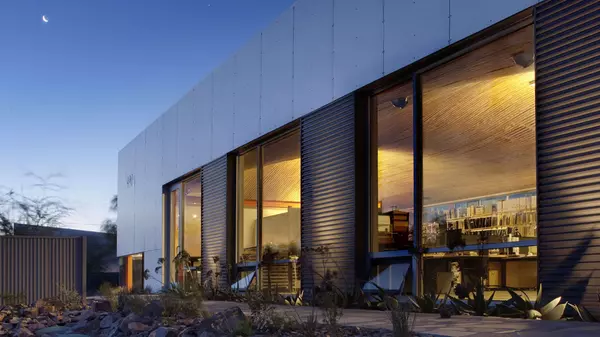What’s the Real ROI on the $300 Million White House Renovation?
Most remodeling projects start with a problem: The kitchen is outdated, the kids need a pool. Or, in the case of the White House Ballroom, the president of the United States requires a place to host world leaders.
Though it looms large in the minds of Americans, the White House is actually quite demure—just 55,000 square feet excluding the East and West wings, according to the White House Historical Association. For perspective, that’s roughly a 15th of the size of Buckingham Palace, which stands closer to 830,000 square feet.
That lack of space has created real problems for the Executive Office of the President, which must construct temporary structures for events larger than 200 people—at a cost that's often $1 million or more, Martin Mongiello, a former White House executive chef and Camp David general manager who has worked under seven administrations, told the BBC.
There’s also the intangible cost of “embarrassment,” he adds, at being “elbow to elbow” during major state functions. That’s why he thinks the ballroom renovation "will eventually pay for itself and save costs.”
It’s a point echoed by White House spokesperson Kush Desai. “The ROI on the White House Ballroom is incalculable,” he tells Realtor.com®. “It’s funded by private donations, not taxpayer dollars, and because not subjecting foreign dignitaries to using porta potties during formal state dinners is priceless.”
Except what began as a $200 million project has now swelled to an estimated $300 million. And like any homeowner who’s watched a remodel spiral beyond its budget, it raises a familiar question (albeit with a few extra zeros on the end): What’s the real return on investment?
The ROI of additions
In traditional real estate, return on investment (ROI) is a straightforward calculation: Subtract what you spent from how much value the project adds.
Appraisers determine that value by comparing your home to similar properties and seeing how much extra buyers are willing to pay for the upgrades you made.
The White House, of course, defies that calculus. There are no comparable properties, and there will never be a buyer. Still, appraisers have taken a swing, estimating its market value at around $1.5 billion, based on a host of assumptions rather than concrete comps.
It’s impossible to pinpoint how much of that value stems from its long history of renovation, but it’s safe to say that the White House’s worth—both symbolic and structural—has been continually reshaped by the upgrades and additions of each era.
Since its cornerstone was laid in 1792, the building has undergone at least 10 major overhauls, including a full reconstruction after it was burned by British forces in the War of 1812, according to the White House’s official website. And today, many of the features that define its grandeur were once just presidential pet projects.
The West Wing, for instance, was added by Theodore Roosevelt in 1902 to separate the president’s office from his family’s residence. The Oval Office followed in 1909, a William Howard Taft innovation that turned architecture into political theater. And the East Wing, completed in 1942 under Franklin D. Roosevelt, is the most recent comparable overhaul, according to Priya Jain, chair of the Society of Architectural Historians’ Heritage Conservation Committee.
If you’re noticing a theme, it’s because there is one: All of these major projects added more functional space.
It’s a familiar tension to homeowners today. Since the pandemic-era run-up in home prices—and the stubbornly high mortgage rates that followed—many homeowners are staying put instead of moving into bigger digs that could better accommodate their needs.
With fewer options and prohibitive expenses to trade up, families are remodeling their way out of space constraints, carving out home offices from closets, finishing basements, or adding backyard ADUs instead of upsizing.
“If you have the land, you’re utilizing the land,” explains Todd Michael Glaser, a notable real estate developer based in Miami. “The land is free in a sense—and every square foot you add is just taking advantage of what you already own.”
He points to Palm Beach, FL, where some waterfront homes have sprawling tennis courts that sit unused for most or all of the year.
“That land can be worth $20 to $25 million on the water,” Glaser says. “If you asked someone at 75 or 80 years old if they’d spend $5 million on a tennis court, they’d say, ‘Are you out of your mind?’ But they already do.”
Rather than let that square footage sit idle, many owners are now repurposing it—replacing courts with new guesthouses, wellness wings, or additions that extend their living space without ever leaving their property.
It’s an impulse that stretches from Palm Beach to Pennsylvania Avenue: When you can’t move up, you make do—and make room.
The plan: A 90,000-square-foot expansion
The new State Ballroom will add roughly 90,000 square feet of ornately designed event space with seating for 650 guests—a major upgrade from the current 200-person capacity of the East Room, according to a White House press release. The administration describes it as “a much-needed and exquisite addition” that will enhance the White House’s ability to host large state functions.
“President Trump is a builder at heart and has an extraordinary eye for detail,” Chief of Staff Susie Wiles said in the release. “The president and the Trump White House are fully committed to preserving the special history of the White House while building a beautiful ballroom that can be enjoyed by future administrations and generations of Americans to come.”
But the project’s funding is sparking scrutiny, after the administration announced that it will be entirely paid for by private donors.
Last week, the administration released a list of benefactors including major corporations like Apple, Google, and Lockheed Martin, as well as private citizens.
The list has already drawn the attention of the Senate Committee on Homeland Security and Governmental Affairs, which has requested more details on the terms of each contribution. Ethics experts warn that such donations could amount to a modern-day pay-to-play arrangement, granting donors long-term influence or access in exchange for their generosity.
Historians and constitutional scholars are also questioning the promises of “zero taxpayer dollars,” and suspect that the project will almost certainly draw on public funds in the long run.
“They can’t live up to that promise over the long term,” Edward Lengel, former chief historian of the White House Historical Association, told Roll Call. “The idea that this is a gift to the American people is really a misdirection.”
He points to the fact that once operational, the ballroom’s maintenance, staffing, security, and communications systems would fall under the executive branch’s annual appropriations, meaning future Congresses would have to foot the bill.
In this case, one might compare the ballroom addition to a homeowner weighing whether or not to put in a pool. It’s a project that requires a huge upfront investment and is so costly to maintain that it can even deter future buyers.
It may seem like nickel and dimming, but they're important distinctions to make when calculating a return on investment. If the ballroom is completely paid for by private donors, it could be a boon, says Realtor.com® senior economic analyst Hannah Jones.
“There is no ‘investment’ if someone else is paying for it,” she explains. “It would be all ‘return.’ Ostensibly, you enjoy all the benefits without any investment.”
But the eventual upkeep of the additional space could cut into that return. Already, the White House is a significant expense for American taxpayers, costing nearly $16 million to keep operational in 2024 alone.
The bigger the project, the smaller the payoff
The White House ballroom addition is hardly the first government renovation to spark controversy.
Most recently, the Federal Reserve Board Building’s modernization became a political flashpoint as the Fed kept benchmark interest rates steady while the cost of its own headquarters renovation swelled from $1.9 billion to $2.5 billion.
Its stated reason: to save money.
“The project will reduce costs over time by allowing the board to consolidate most of its operations. It involves a complete overhaul and modernization that preserves two historic buildings that have not been comprehensively renovated since their construction in the 1930s,” the Board of Governors website reads.
A decade earlier, the Consumer Financial Protection Bureau faced similar scrutiny. Lawmakers questioned why an agency renting its headquarters from the federal government was spending $145 million to remodel it.
Once again, the reasoning was to bring down costs through modernization.
“The renovations that are performed there will make the building serviceable for years to come,” CFPB Director Richard Cordray said at the time.
Both episodes point to the same truth about America’s public buildings: Preserving history while maintaining functionality in buildings 100 years or older is an expensive endeavor. And it’s only getting more so.
“Rising material costs, persistent labor shortages, and lingering supply chain disruptions have all driven renovation expenses higher, eroding potential returns on investment,” explains Jones. “As a result, large, labor- and material-intensive projects are yielding more modest financial paybacks.”
A return measured in legacy, not dollars
That financial pressure is why few high-end remodels ever pay for themselves, according to the National Association of Realtors® 2025 Remodeling Impact Report.
A major kitchen renovation typically recoups around 60% of its cost, while a new primary suite addition—the closest civilian equivalent to the White House ballroom—recovers about 54%. In short, the bigger the project, the smaller the financial payoff.
By contrast, small, functional upgrades like a steel front door can recoup 100% of the investment. The math makes one thing clear: Glamour projects tend to deliver more joy than dollars.
But since the White House isn’t destined for the market, the calculus may be flipped.
“It’s more about enjoyment,” says Glaser, describing large, high-budget projects. “[Owners] benefit on the way out, but they’re not doing it for that—they’re doing it to enjoy the property.”
The same could be said for the People’s House. The additions taken on by presidents past and present may not have delivered a financial windfall, but they were never about resale value. The payoff of these renovations is calculated on a return on pride, legacy, and utility.
Categories
Recent Posts










GET MORE INFORMATION

Stevan Stanisic
Real Estate Advisor | License ID: SL3518131
Real Estate Advisor License ID: SL3518131
